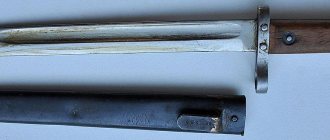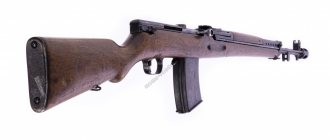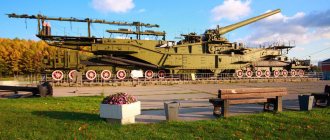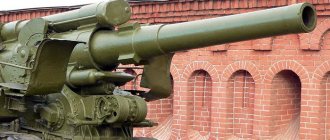Operating principle
The original percussion flint lock began to be used in weapons in the first half of the 16th century in the Middle East.
At the same time, the wheel mechanism was also widely used. In the European part, such a castle gained its popularity first of all in Spain. The design features made it possible to widely use the impact lock, which, due to its advantages, very quickly replaced the wheel and wick mechanisms. The impact lock was installed on all types of weapons for two centuries, until the original capsule systems and unitary cartridges appeared. The ignition of gunpowder in the impact lock is carried out by means of a spark, which is obtained as a result of the impact of a cocked trigger with a small piece of silicon on a special steel plate called a flint. Such a spark ignites an intermediate amount of gunpowder, which is located on the shelf. Next, through a special seed hole, the main charge is ignited, which releases the energy for the shot.
To fire a shot, you must cock the hammer and put it on a special safety lock. Next, you need to open the cavity of the seed shelf and put gunpowder there. The loaded chamber must be closed and the hammer cocked into the firing position. Loading the gun is carried out using a certain amount of gunpowder, which is measured by a special dispenser. The gunpowder must be compacted with a wad, loaded with a bullet, confined to another wad, and everything carefully compacted using a long cleaning rod. The flint, which is fixed on special jaws of the trigger, produces a spark when it hits the shelf cover. It ignites a seed portion of gunpowder, which ignites the main amount of gunpowder required to fire a shot.
Peculiarities
The flintlock pistol of the Russian army, model 1809, has a barrel that is attached to the stock from the muzzle side using a special ring, which also protects the end part of the forearm from chipping. In the breech compartment, the element is fixed with a screw connecting the shank of the breech bolt to the trigger cylinder. The brass bracket is located in the front compartment, supported by a transverse pin that fits into the socket of the longitudinal protrusion in the stock.
The rear trigger part of the guard is held in place by a screw screwed into the cylinder with the cypher of Emperor Alexander the First under the crown. The length of the trigger is 22 millimeters, the width is 8 mm, it is located on the axis of the transverse pin. The weapon is equipped with a flintlock with dimensions of 142/86/27 mm, which is mounted using a pair of screws
The lock cylinder has an L-shaped configuration, holds the fastener heads, presses the structure tightly to the stock, and the powder flange to the barrel in the area of the seed socket. The second element is also made of brass and serves to protect the mechanism from high temperature and combustion products after firing. The lid with a curved smooth flint has dimensions of 40/23 millimeters.
The trigger is equipped with a combat and safety cocking type, the maximum distance for moving the part in the first case is 35 mm, in the second - 15 mm. The force required to activate the trigger is significant (about 8 kg). The sight is a rounded brass front sight with dimensions of 23/4/2 mm.
History of this sample
At the end of the 17th century, all matchlock weapons were massively replaced by mechanisms with impact flintlocks. This special mechanism opened a new era in the history of firearms manufacturing. After the use of the flintlock began, firearms gained high popularity and became widely accepted among the masses.
A real pearl of the tsarist period of weapon production is the original flintlock percussion carbine. Such weapons were produced in memory of the historical visit of Empress Catherine II to the weapons factory in Tula in 1775.
The original design of the carbine consists of a unique stock, which is made of expensive noble wood and covered with exquisite ornaments, elegantly lined with gold and silver. At the base of the trigger there is a special pad that has the shape of an unidentified animal. The main design elements of the carbine, including the original percussion flintlock, various decorative screws, a special trigger guard and the breech of the unique barrel, are additionally decorated in the form of gilded reliefs of floral patterns.
The breech of the barrel has a special oval protrusion, which places the original gold monogram of Empress Catherine. This monogram is decorated by Tula craftsmen in the form of special steel diamonds.
The outer surface of the carbine, which is made of special metal, is blued. All necessary inscriptions are outlined in golden reliefs. A unique cleaning rod made of expensive wood has a special head made of black horn at the end.
Literature
- Fedorov V.
Evolution of small arms. Part I. Development of handguns from muzzleloading and flintlock to repeating rifles. - M.: State Military Publishing House of the People's Commissariat of Defense of the USSR, 1938 - Zhuk A. B.
Encyclopedia of small arms. - M.: Voenizdat, 1998. - Makovskaya L.K.
Hand-held firearms of the Russian army of the late XIV-XVIII centuries. Determinant. M.: Military Publishing House, 1992 [militarist.milua.org/makovskaya/images/makovskaya.htm] - Beheim V.
Encyclopedia of weapons. Guide to weapons science. Weaponmaking in its historical development from the beginning of the Middle Ages to the end of the 18th century. - Leipzig, 1890. - St. Petersburg: JSC "St. Petersburg Orchestra", 1995. [annales.info/evrope/behaym/behaym.htm] - Milchev M.
Small arms ignition systems. Part V.//"Gun", No. 3, 2011, p. 54-60
Development
Flintlocks for weapon making began to be used in Europe as early as 1504. The first to use this type of weapon craftsmanship were Spanish craftsmen. After long use in weapons production, flintlocks quickly spread throughout Europe. This system had its advantages and disadvantages.
The basic principle of operation of this mechanism is a certain order of ignition. The intermediate charge of gunpowder is ignited by a spark, which is formed as a result of the impact of a flint piece on a special metal tip. This system completely eliminates the use of a wick as an igniter. This simplification and maximum efficiency of this system were widely used in the production of weapons of that time.
The first attempts to use this system in the production of weapons in our country met with a certain distrust, which soon gave way to full support. In the early stages of the introduction of flintlocks, combined production methods were used. But such moments did not last long. The flintlock system quickly established itself as a high-quality and reliable mechanism. The most important role in the spread of flintlocks was played by German gunsmiths. In Russia, the flintlock system was used for 150 years.
There are two main directions in the development of flintlock systems. They belong to the Mediterranean and Baltic branches, respectively. The Mediterranean direction of development of the use of flintlocks is distinguished by a special design, which provides for small overall dimensions and a certain weight of the product. This school developed in Western Europe. The Baltic system of castles was distinguished by a more elongated shape, which resulted in increased dimensions. Both schools of development had their differences, which consisted of various variations and modifications of flintlocks. One of the most famous gunsmiths of that time, MARIN LE BOURGEOIS, managed to combine both systems, creating a unique flintlock, which was the most in demand over the next three centuries.
french flint castle
1 - trigger 2 - trigger screw 3 - upper lip of the trigger 4 - flint 5 - cover (flint) 6 - shelf 7 - bending spring
Device
The flintlock pistol, the photo of which is given below, consists of a barrel, a percussion lock, a stock and a brass fixture. Brief characteristics:
- Year of manufacture: 1809.
- Total length – 43.5 cm.
- Weight – 1.5 kg.
- The material for making the stock is solid wood (walnut or birch).
- The forend is long to the muzzle.
- There is no ramrod entrance.
The handle of the weapon is equipped with a brass butt plate and a pair of side “antennae”. The length of the handle is about 160 millimeters with a maximum thickness of 50 mm at the bottom. The reinforced butt plate made it possible, after a salvo, to use the musket as a bladed impact weapon.
Barrel parameters:
- Configuration – conical.
- Length – 26.3 cm.
- Caliber – 7 lines (17.7 mm).
- Round cross-section at the muzzle.
- The thickness at the breech is 31 mm.
- The thread pitch of the internal part is about 4.5 turns per 10 mm.
Application
The unique percussion flintlock was used in the production of all types of weapons, for combat and hunting purposes. That is why this type of weapon did not differ much in design from each other. The most popular types of weapons during the reign of Catherine the Great were hunting weapons, since she loved game and massively promoted hunting rules.
It was on the orders of the Empress that the most promising and experienced gunsmiths from Tula produced original copies of hunting weapons. Such models were distinguished by excellent decorative finishing, unique technical characteristics and structural perfection of that time. When making hunting weapons, Tula professionals used an original percussion flintlock.
At the beginning of the 18th century, the main manufacturer of flintlock mechanisms were the best gunsmiths of the weapons factory in Tula. These weapon models did not have such an expensive finish as the imperial ones, but were distinguished by maximum reliability and practicality. Extensive experience in the production of original weapons allowed modern craftsmen to constantly improve their skills, producing higher quality flintlock products.
In the period from 1812 to 1814, gunsmiths from Tula produced and completely restored more than 500 thousand units of original weapons with percussion flintlocks. A feature of the flintlock was the maximum technological effectiveness of its time. It is this feature that has given this type of weapon a certain popularity and widespread use in various types of production. Another feature of the flintlock was its high reload speed, which made it possible to fire 2-3 shots per minute, which was quite a significant indicator at that time. In some cases, when conducting combat battles, infantrymen achieved results of 6-7 rounds per minute, which was an excellent indicator. This rate of fire was achieved due to special changes in the design of the gun itself and the original flintlock.
Battle of Borodino
The main disadvantages of a flintlock
The main disadvantage of the flintlock was the need for regular and careful maintenance of the system. With proper attention and care, the flintlock provided the required rate of fire. Sometimes misfires occurred, which were characterized by poor fixation of the flint or its wear. Problems with ignition arose due to damp gunpowder, which could not be stored in a charged state for a long time. But even a fully functional flintlock could make up to 15 different misfires per 100 shots fired. The remaining disadvantages of this ignition system were inherited from previous developments by gunsmiths. With an approximate amount of gunpowder in the charge, an uneven shot was obtained, which could not guarantee a high degree of accuracy and range. The cloud of smoke after the shot significantly reduced the shooter's visibility when preparing for the next shot.
Weapons with the original flintlock were widely used throughout the world until the beginning of the 19th century. In private, this type of weapon was used for a certain period of time, since in our country, guns with flintlocks were manufactured until 1884. Today, the original flintlock weapon is a real rarity. In some countries, various events are held using replicas of single-shot flintlock rifles as entertainment. Although there is also actual use of weapons with a flintlock. For example, by individual tribes in Africa, sometimes to maintain traditions, and sometimes due to the lack of other weapons for hunting.
An excerpt characterizing the Impact Flintlock
- But you have to go? - said Nikolai. - Come to me with Uvarka. - As you order! - So wait a minute to feed. – I’m listening. Five minutes later, Danilo and Uvarka stood in Nikolai’s large office. Despite the fact that Danilo was not very tall, seeing him in the room produced an impression similar to when you see a horse or a bear on the floor between the furniture and the conditions of human life. Danilo himself felt this and, as usual, stood at the very door, trying to speak more quietly, not to move, so as not to somehow damage the master’s chambers, and trying to quickly express everything and go out into the open space, from under the ceiling to the sky. Having finished the questions and having elicited Danila’s consciousness that the dogs were okay (Danila himself wanted to go), Nikolai ordered them to saddle up. But just as Danila wanted to leave, Natasha entered the room with quick steps, not yet combed or dressed, wearing a large nanny’s scarf. Petya ran in with her. - You are going? - said Natasha, - I knew it! Sonya said that you won’t go. I knew that today was such a day that it was impossible not to go. “We’re going,” Nikolai answered reluctantly, who today, since he intended to undertake a serious hunt, did not want to take Natasha and Petya. “We’re going, but only after the wolves: you’ll be bored.” “You know that this is my greatest pleasure,” Natasha said. “This is bad,” he rode himself, ordered him to saddle, but didn’t tell us anything. – All obstacles to the Russians are in vain, let’s go! – Petya shouted. “But you’re not allowed to: Mama said you’re not allowed to,” said Nikolai, turning to Natasha. “No, I’ll go, I’ll definitely go,” Natasha said decisively. “Danila, tell us to saddle up, and for Mikhail to ride out with my pack,” she turned to the hunter. And so it seemed indecent and difficult for Danila to be in the room, but to have anything to do with the young lady seemed impossible to him. He lowered his eyes and hurried out, as if it had nothing to do with him, trying not to accidentally harm the young lady. The old count, who had always kept a huge hunt, but now had transferred the entire hunt to the jurisdiction of his son, on this day, September 15th, having fun, got ready to leave too. An hour later the whole hunt was at the porch. Nikolai, with a stern and serious look, showing that there was no time to deal with trifles now, walked past Natasha and Petya, who were telling him something. He inspected all parts of the hunt, sent the pack and hunters ahead to the race, sat down on his red bottom and, whistling the dogs of his pack, set off through the threshing floor into the field leading to the Otradnensky order. The old count's horse, a game-colored mering called Bethlyanka, was led by the count's stirrup; he himself had to go straight in the droshky to the hole left for him. Of all the hounds, 54 dogs were bred, under which 6 people went out as handlers and catchers. In addition to the masters, there were 8 greyhound hunters, who were followed by more than 40 greyhounds, so that with the master's packs about 130 dogs and 20 horse hunters went out into the field. Each dog knew its owner and name. Each hunter knew his business, place and purpose. As soon as they left the fence, everyone, without noise or conversation, stretched out evenly and calmly along the road and field leading to the Otradnensky forest. The horses walked across the field as if walking on a fur carpet, occasionally splashing through puddles as they crossed the roads. The foggy sky continued to descend imperceptibly and evenly to the ground; the air was quiet, warm, soundless. Occasionally one could hear the whistling of a hunter, the snoring of a horse, the blow of an arapnik, or the yelp of a dog that was not moving in its place. Having ridden about a mile away, five more horsemen with dogs appeared from the fog to meet the Rostov hunt. A fresh, handsome old man with a large gray mustache rode ahead. “Hello, uncle,” Nikolai said when the old man drove up to him. “It’s a real march!... I knew it,” said the uncle (he was a distant relative, a poor neighbor of the Rostovs), “I knew that you couldn’t stand it, and it’s good that you’re going.” Pure march! (This was my uncle’s favorite saying.) - Take the order now, otherwise my Girchik reported that the Ilagins are standing in Korniki with pleasure; You have them - pure march! - they will take the brood under your nose. - That's where I'm going. What, to bring down the flocks? - Nikolai asked, - get out... The hounds were united into one pack, and uncle and Nikolai rode side by side. Natasha, wrapped in scarves, from under which a lively face with sparkling eyes could be seen, galloped up to them, accompanied by Petya and Mikhaila, the hunter who was not far behind her, and the guard who was assigned as her nanny. Petya laughed at something and beat and pulled his horse. Natasha deftly and confidently sat on her black Arab and with a faithful hand, without effort, reined him in. Uncle looked disapprovingly at Petya and Natasha. He did not like to combine self-indulgence with the serious business of hunting. - Hello, uncle, we're on our way! – Petya shouted. “Hello, hello, but don’t run over the dogs,” the uncle said sternly. - Nikolenka, what a lovely dog, Trunila! “he recognized me,” Natasha said about her favorite hound dog. “Trunila, first of all, is not a dog, but a survivor,” thought Nikolai and looked sternly at his sister, trying to make her feel the distance that should have separated them at that moment. Natasha understood this. “Don’t think, uncle, that we will interfere with anyone,” said Natasha. We will remain in our place and not move. “And a good thing, countess,” said the uncle. “Just don’t fall off your horse,” he added: “otherwise it’s pure marching!” – there’s nothing to hold on to. The island of the Otradnensky order was visible about a hundred yards away, and those arriving were approaching it. Rostov, having finally decided with his uncle where to throw the hounds from and showing Natasha a place where she could stand and where nothing could run, set off for a race over the ravine. “Well, nephew, you’re becoming like a seasoned man,” said the uncle: don’t bother ironing (etching). “As necessary,” answered Rostov. - Karai, fuit! - he shouted, responding with this call to his uncle’s words. Karai was an old and ugly, brown-haired male, famous for the fact that he single-handedly took on a seasoned wolf. Everyone took their places. The old count, knowing his son’s hunting ardor, hurried not to be late, and before those who arrived had time to drive up to the place, Ilya Andreich, cheerful, rosy, with trembling cheeks, rode up on his little black ones along the greenery to the hole left for him and, straightening his fur coat and putting on his hunting clothes, shells, climbed onto his smooth, well-fed, quiet and kind, gray-haired Bethlyanka like him. The horses and droshky were sent away. Count Ilya Andreich, although not a hunter by heart, but who firmly knew the hunting laws, rode into the edge of the bushes from which he was standing, took apart the reins, adjusted himself in the saddle and, feeling ready, looked back smiling. Next to him stood his valet, an ancient but overweight rider, Semyon Chekmar. Chekmar kept in his pack three dashing, but also fat, like the owner and the horse - wolfhounds. Two dogs, smart, old, lay down without packs. About a hundred paces further away in the edge of the forest stood another of the Count's stirrups, Mitka, a desperate rider and passionate hunter. The Count, according to his old habit, drank a silver glass of hunting casserole before the hunt, had a snack and washed it down with a half-bottle of his favorite Bordeaux. Ilya Andreich was a little flushed from the wine and the ride; his eyes, covered with moisture, shone especially, and he, wrapped in a fur coat, sitting on the saddle, had the appearance of a child who was going for a walk. Thin, with drawn-in cheeks, Chekmar, having settled down with his affairs, glanced at the master with whom he lived for 30 years in perfect harmony, and, understanding his pleasant mood, waited for a pleasant conversation. Another third person approached cautiously (apparently he had already learned) from behind the forest and stopped behind the count. The face was that of an old man with a gray beard, wearing a woman's hood and a high cap. It was the jester Nastasya Ivanovna. “Well, Nastasya Ivanovna,” the count said in a whisper, winking at him, “just trample the beast, Danilo will give you the task.” “I myself... have a mustache,” said Nastasya Ivanovna. - Shhh! – the count hissed and turned to Semyon. – Have you seen Natalya Ilyinichna? – he asked Semyon. - Where is she? “He and Pyotr Ilyich got up in the weeds from the Zharovs,” answered Semyon, smiling. - They are also ladies, but they have a great desire. - Are you surprised, Semyon, how she drives... huh? - said the count, if only the man was in time! - How not to be surprised? Boldly, deftly. -Where is Nikolasha? Is it above the Lyadovsky top? – the count kept asking in a whisper. - That's right, sir. They already know where to stand. They know how to drive so subtly that sometimes Danila and I are amazed,” said Semyon, knowing how to please the master. - It drives well, huh? And what about the horse, huh? - Paint a picture! Just the other day, a fox was snatched from the Zavarzinsky weeds. They began to jump over, out of delight, passion - the horse is a thousand rubles, but the rider has no price. Look for such a fine fellow! “Search...,” the count repeated, apparently regretting that Semyon’s speech ended so soon. - Search? - he said, turning away the flaps of his fur coat and taking out a snuff box. “The other day, as Mikhail Sidorich came out from mass in full regalia...” Semyon did not finish, hearing the rut clearly heard in the quiet air with the howling of no more than two or three hounds. He bowed his head, listened and silently threatened the master. “They’ve attacked the brood...” he whispered, and they led him straight to Lyadovskaya. The count, having forgotten to wipe the smile from his face, looked ahead along the lintel into the distance and, without sniffing, held the snuffbox in his hand. Following the barking of the dogs, a voice was heard from the wolf, sent into Danila’s bass horn; the pack joined the first three dogs and the voices of the hounds could be heard roaring loudly, with that special howl that served as a sign of the rutting of the wolf. Those arriving no longer squawked, but hooted, and from behind all the voices came Danila’s voice, sometimes bassy, sometimes piercingly thin. Danila’s voice seemed to fill the entire forest, came out from behind the forest and sounded far into the field. After listening in silence for a few seconds, the count and his stirrup became convinced that the hounds had split into two flocks: one large one, roaring especially hotly, began to move away, the other part of the flock rushed along the forest past the count, and in the presence of this flock Danila’s hooting could be heard. Both of these ruts merged, shimmered, but both moved away. Semyon sighed and bent down to straighten the bundle in which the young male was entangled; The count also sighed and, noticing the snuff-box in his hand, opened it and took out a pinch. "Back!" Semyon shouted at the dog, who stepped out beyond the edge. The Count shuddered and dropped his snuffbox. Nastasya Ivanovna got down and began to lift her. The Count and Semyon looked at him. Suddenly, as often happens, the sound of the rut instantly came closer, as if, right there in front of them, there were the barking mouths of dogs and the hooting of Danila. The count looked around and to the right he saw Mitka, who was looking at the count with rolling eyes and, raising his hat, pointed him forward, to the other side. - Take care! - he shouted in such a voice that it was clear that this word had been painfully asking him to come out for a long time. And he galloped, releasing the dogs, towards the count. The Count and Semyon jumped out of the edge of the forest and to their left they saw a wolf, which, softly waddling, quietly jumped up to their left to the very edge at which they were standing. The evil dogs squealed and, breaking away from the pack, rushed towards the wolf past the legs of the horses.
Modernity
Ancient muskets in their original design can now only be seen in museums or from real collectors. Nevertheless, specialized retail outlets and online sites offer copies that are as similar as possible to their ancient descendants. Gamers do not ignore the weapons in question either. For example, in the popular game "Forest", a flintlock pistol is considered one of the most formidable melee items. True, finding it and the charges for it, even in an interactive shooter, is quite difficult.











